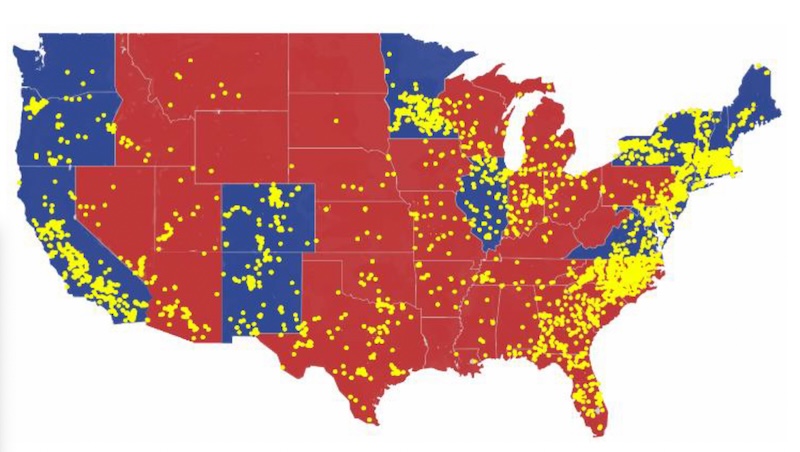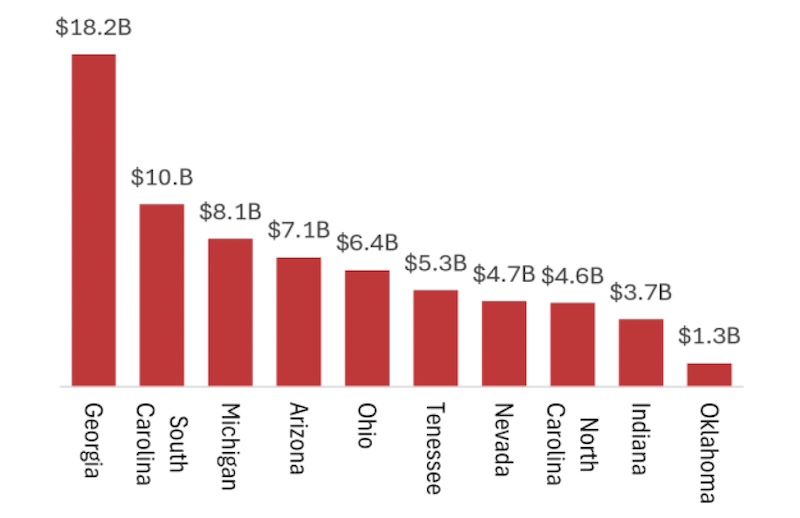The Future of Solar under a Second Trump Term
The re-election of President Trump undoubtedly increases uncertainty for the solar industry. However, there are several aspects of President Trump’s past policies, proposed policies, rhetoric, choice of allies, and current state of the industry that counter the doom and gloom story. It’s possible we could be at the beginning of four bright years for solar.
Policies During the First Trump Term
In 2018 the Trump administration implemented tariffs on Chinese modules. These tariffs started the turnaround of domestic solar panel manufacturing that had almost been completely decimated in 2017, which saw a 43% decline to only 970MW (source, source). By Q1 of 2019, domestic solar panel manufacturing had rebounded to 1.4GW of production, growing to 4.4 GW in 2020 (source). This is attributed to not only the Trump tariffs, but also due to Trump’s favorable corporate tax policies (source, source). In fact, they were so successful, they were continued and even expanded under the Biden administration.
In 2018 Trump also implemented tariffs on aluminum extruded products, a major component for most solar panels. Due to the tariffs, domestic aluminum production saw an increase in aluminum smelting of 38%, $6B in new investments including new facilities, and the addition of 4,500 new jobs (source). In hindsight, the growth of domestic aluminum production capacity due to Trump’s tariffs seems prophetic since it aligned perfectly to support the domestic content provision of Biden’s landmark climate legislation, the Inflation Reduction Act (IRA) which supercharged solar panel manufacturing to 31 GW/yr (source).
So, while the Trump years were not necessarily a boon for solar like the Biden years, they were formative and laid the groundwork for where we are today, a $60B industry (source).
Policies to Expect During the Next Trump Term
Historically, Trump’s rhetoric on solar and electric cars was skeptical at best. However, there has been a definitive shift over the last year. His recent relationship with Elon Musk, arguably the biggest domestic promotor of solar, and RFK Jr., an environmental lawyer, along with his statement that he’s “a big fan of solar” during his debate with Vice President Harris are evidence of a shift. As part of his victory speech, Trump expressed his support for RFK Jr. with the caveat of leaving oil and gas alone. This suggests that RFK Jr. might have the president’s ear when it comes to clean renewable solar energy which would fit well with RFK Jr.’s mandate of “Make America healthy again”.
It could be that Trump’s evolution with respect to solar has to do with the fact that many red states have seen significant investments in solar. In fact, as shown below, when overlaying a map of solar farms (source) with the electoral map it is clear that solar is as popular in blue states as it is in red. Take Texas, where Solvari is located, as an example. Trump won here by 14 points while at the same time Texas installed 5.5GW of solar capacity in just the first half of 2024 continuing their trend as a national leader in solar deployment. (source)
Locations of large-scale solar farms

In addition, announcements of billions of dollars of clean energy manufacturing investments spurred by the IRA have almost exclusively been focused in red states (source).
Top 10 states for new clean energy manufacturing investments are in red states

To drive the point home even further, when we look at solar related US manufacturing, there are significant concentrations in the south and the mid-west which went heavily towards Trump in the election (source).
Locations of Solar Related Manufacturing

Taking all these factors into account, it’s not surprising we have seen a change in Trump’s rhetoric. If nothing else, Trump has been consistent in his support of business and economic growth, and his constituents are thriving from the benefit of a growing solar industry.
Trump, Tariffs, and the IRA
While some incentives of the IRA are investments in cleantech, others take the form of tax credits, like the 30% tax credit for residential installations. In 2022, three of the top four states for residential solar installation were red states (AZ, TX, FL) (source). Residents in these states were able to take advantage of the IRA tax credits to become energy independent and disaster resilient. Trump has been consistent in supporting tax credits, both as President and during the campaign. It would be out of character for him to take tax credits away from his supporters. In fact, during his first term, Trump left the federal tax credits for solar intact, electing to neither decrease the rate of decline as was wanted by the solar industry, nor eliminate them as was wanted by some of his Republican colleagues. The current tax credits are not set to begin their step down until well after Trump’s next term is over. Considering his past decisions and current sentiment, it seems unlikely he would make any changes to the current tax incentives for solar, especially for residential solar where Solvari operates.
As discussed earlier, the 10% tax credit for domestic content for solar panels also seems to align with Trump’s America first agenda and proposed tariffs to stimulate domestic manufacturing. While tariffs make goods more expensive, it also brings stability to US manufacturing and the job market. Oversupply of low-cost Chinese solar panels has wreaked havoc on the Chinese solar manufacturing industry with many smaller players being driven out of the market and net losses reported by some of the largest manufacturers (source). Meanwhile, domestic solar panel manufacturing has increased its capacity by 11 GW, a 71% increase, in Q1, 2024 alone (source). Current US policy, spearheaded by Trump and strengthened by the IRA is working, and is providing stability in an otherwise chaotic market.
Trump Tax Cuts
Once again, Trump is promising to bring back tax cuts for both business and individuals. This would free up cash which could be used to fund new solar ventures and put more solar on rooftops. It’s possible that the combination of Biden tax credits and Trump tax cuts provide an unprecedented positive environment to accelerate solar deployment, especially for residential.
Conclusion
The rate of increased energy demand is projected to accelerate over the coming years with the addition of data centers, increased manufacturing, hotter and longer summers, and electric vehicles. The US needs more energy and solar is a proven, reliable, and low-cost solution that can help maintain the grid’s stability during trying times (source). It’s too late to put the genie back in the bottle. Solar is here to stay and it’s an integral and growing part of the US economy. Trump’s pro-business policies, support for US manufacturing, and focus on economic growth, align with the solar industry’s recent strides. Trump’s economic policy hinges on growth, and he doesn’t care where it comes from. We just need to keep doing what we’re doing, and solar will continue to shine.
Solvari | https://www.solvarisolar.com












